Managing Project Risk - Free eBook in PDF Format
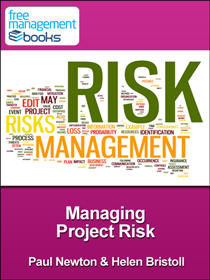 |
 |
|
Book Description - ISBN 978-1-62620-986-4 (39 Pages)
Every project involves risks and every project needs to have a management strategy for dealing with the threats and opportunities represented by each risk. This eBook explains the key issues and concepts involved in effective risk management in a clear and accessible way, providing a comprehensive approach that is applicable to all sizes of project, whether requiring detailed, quantitative analysis or a rougher approach using only qualitative analysis.
Chapter 1 - Managing Project Risk
A risk is a future event that may or may not happen, but if it does occur it will have an effect on project scope, schedule, cost, or quality. It may have one or more causes and, if it occurs, it may have one or more impacts. All project activities carry some element of risk, which are uncertainties about them that could affect the project for better or worse. It is important to understand the difference between business risks and project risks.
Chapter 2 - Creating a Risk Management Plan
This plan details how the project management team will undertake to manage the risks associated with this project. It does not involve actually identifying project risk. The aim of the Risk Management Plan is to ensure that the risk management protocol that is used on the project is commensurate with both the risks and the importance of the project to the organization. Establishing this protocol early on in the project ensures that all members of the project management team are using the same methods to evaluate risks and that the risk management tasks are budgeted for in the project plans.
Chapter 3 - Identifying Project Risks
This involves determining what risks may affect the project and assessing the impact of the risk should it occur. This information is documented in the risk register, a list of all of the identified risks, their root causes, categories and responses. Because the assessment of risk is an ongoing activity, the risk register will be updated continuously throughout the life of the project. All project team members should be encouraged to identify risks and this is an iterative process because new risks may become known as the project progresses. By ensuring the whole project team are involved in the identification of risks, they will have a sense of ownership and responsibility for both the risks and associated risk response actions.
Chapter 4 - Performing Risk Analysis
Using the risk register each risk is now analyzed in terms of its probability and impact on the project if it were to occur. It should be performed as soon as possible after risks have been identified so that appropriate time and resources can be allocated to the more serious risks. It uses the probability and impact matrix (PIM) to rank and prioritize risks, and this information is placed back on the risk register. Like all of the activities within risk management, this one should be performed regularly because new risks will be identified and the characteristics of existing risks may change as the project progresses. The availability of time and budget, and the need for qualitative or quantitative statements about risk and impacts, will determine which method(s) to use.
Chapter 5 - Planning and Controlling Risk Responses
Having identified and assessed each risk you need to develop the options and actions to enhance opportunities and to reduce threats to the project. It is important that planned responses are appropriate to the significance of the risk, cost effective in meeting the challenge, realistic within the project context, agreed upon by all parties involved, and owned by a responsible person. Planned risk responses that are included in the project management plan are executed during the life cycle of the project, but the project work should be continuously monitored for new, changing, and outdated risks.
| You will learn: |
|
![]()
![]()
Everything that is done in business contains some measure of risk. No matter what the activity, there is an element of risk that must be analyzed and weighed against the potential rewards. The best organizations are those who can choose the right risks to take on, and the ones to avoid.
Dealing with too little risk often means that the organization is being too conservative and is limiting their potential for growth - too much risk, however, and the company is likely to crash and burn at some point along the way.
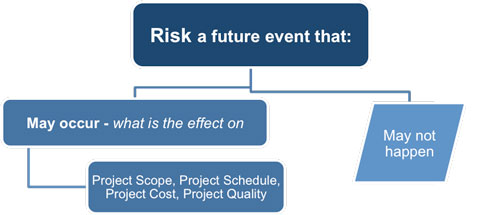 |
As projects are a regular part of business, it only stands to reason that they incur a certain level of risk as well. Managing project risk deals with the activities involved in identifying potential risks, assessing and analyzing them, finally monitoring them throughout the life of a project. Every project will have a unique set of risks based on the specific details of the work being done. It is often up to the project manager to outline these risks ahead of time and include them as part of the overall plan of the project.
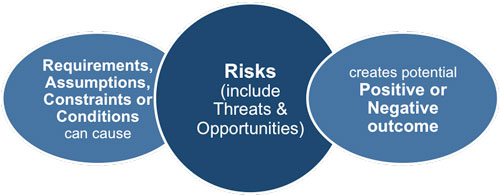 |
Dealing with the risk inside of a project isn't much different from dealing with any other business risks that you encounter. While it probably isn't possible to foresee all potential risks that could come down the line, planning for as many of them as you can will give the project its greatest chance at success.
Identifying the Risks
Before a project even gets started, it is essential that any potential risks are identified and a strategy for managing such risks developed. One of the best ways to do this is by learning from past experience - either your own experiences, or those of the organization as a whole.
Even if the type of project you are working on presently is different than anything you have done before, it is likely the organization has already done something at least remotely similar. Look back on those projects to see how they played out. Did anything pop up along the way that you could be ready for this time? Learning from the past is the best way to predict the future, especially in business.
Another risk identification strategy to use is speaking with all of the members of the project team and asking for their input. Although they might not have the same high-level view of the project that you do as manager, they likely have a great deal of knowledge within their specific field of expertise. Ask them to highlight the potential risks that they see developing down the line and work on making plans for those possibilities as well. There is only one output of this process and that is the all important risk register, which plays a key role in how well a project is monitoring during its execution.
 |
Among the most common risks that need to be dealt with are losing key members of the team partway through the project, or running out of money to see the project all the way through to completion. In the case of both of those risks, there are steps that can be taken to mitigate the damage they would do and be prepared in the event that they do occur. For example, having redundancy within your team can help to limit the damage if a team member moves on to another job partway through the work, and building the project in such a way that it can be 'paused' while waiting for more funds could prevent it from being completely wiped out by a temporary lack of funding.
Evaluating the Risks
With a list in place that highlights which risks you will be taking on during the project, you can start looking closely at each of them and deciding what kind of threat they actually are. Is the risk something that would do long-term damage to the organization if it came to pass? Usually, risks that fall into this category are of the legal variety.
A project that could put you in legal trouble for one reason or another is often one to be avoided. However, if the worst-case for a project is simply some wasted time and a small amount of wasted capital, you may decide that those risks are worth the potential reward. It is all about balance in risk management, so the pros and cons have to be weighed carefully with respect to each potential risk.
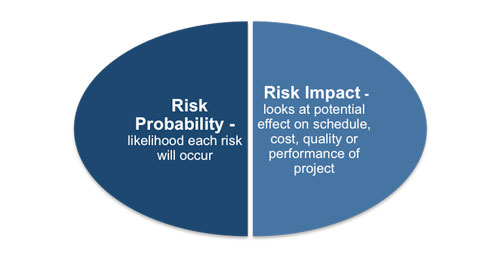 |
Both qualitative and quantitative analysis must be performed for each risk. Firstly, each risk is assessed and rated according to its likely probability and then secondly on the impact it would have on the project if it happened. There are a variety of tools that are used to assist in these processes:
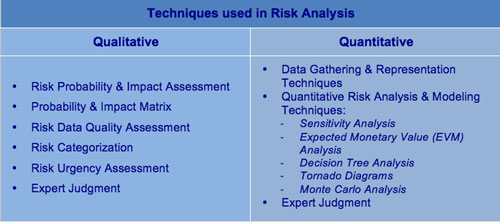 |
Qualitative Risk Analysis
• Risk Probability & Impact Assessment
• Probability & Impact Matrix
• Risk Data Quality Assessment
• Risk Categorization
• Risk Urgency Assessment
• Expert Judgment
Quantitative Risk Analysis
• Sensitivity Analysis
• Expected Monetary Value (EMV) Analysis
• Decision Tree Analysis
• Tornado Diagrams
• Monte Carlo Analysis
Beyond what kind of damage a certain risk could do is the consideration of how likely that risk is to occur. For example, a risk that is very likely to occur and would also be highly damaging to the company is one to take very seriously. On the other hand, a risk that is unlikely to be realized and also wouldn't do much harm is one that you can mostly ignore.
Mitigating the Risks
This was touched on briefly above as far as taking steps to limit the damage that any of your potential risks would do. The easiest example to understand is the one regarding members of the team. When you are building a team to work on the project, keep in mind that not every team member will see the project through from start to finish. If you only have one person who is capable of performing a vital portion of the work, you are exposed to risk if that person should leave for any reason. Instead, there should be as much redundancy as possible - especially in the critical areas of the project - so the loss of one or two people along the way doesn't derail the entire project.
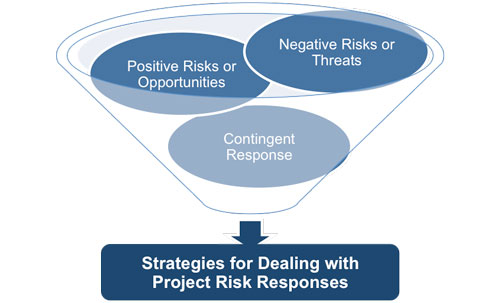 |
Doing what you can to limit your exposure to risk throughout the project, while still giving the project a chance to succeed is the task that a project manager takes on. No one likes to have to deal with risk, but it is an unavoidable part of doing business.
The best that can be done is to evaluate each risk that you might face, and weigh it against the potential rewards that are waiting at the end of the project. Project managers also plan how they will control risks using a variety of tools and techniques shown in the diagram below.
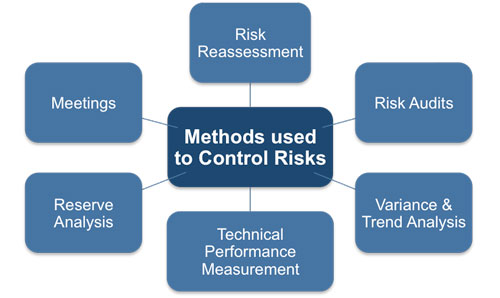 |
The goal is to make the level of risk acceptable to the organization and to take steps that minimize the element of risk as much as possible.


